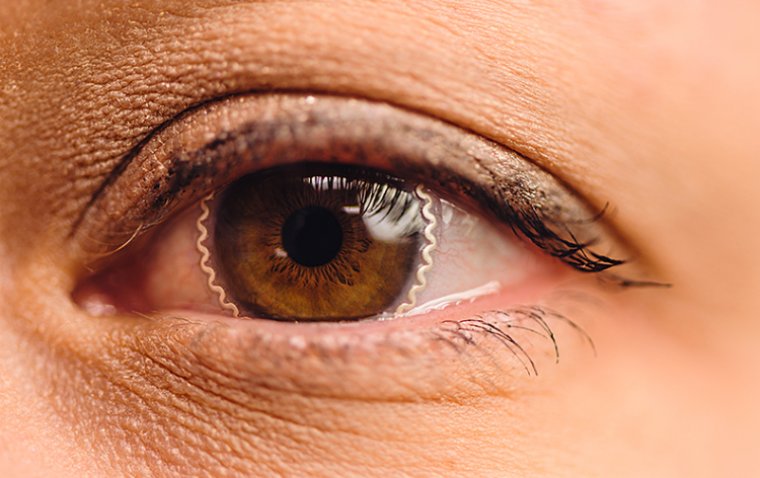Scientists Develop Eye-Tracking Smart Contact Lenses with Radio Frequency Tags
Scientists from Nanjing, China, have developed a novel eye-tracking smart contact lenses based on radio frequency tags, offering diverse applications in health care and augmented reality (AR). These innovative lenses are biocompatible, imperceptible, and operate without a battery or conventional silicon chips.
Smart contact lenses, capable of monitoring various health factors and facilitating human-machine interaction (HMI), are an emerging technology. Traditional eye-tracking methods like pupil center corneal reflection and electrooculography (EOG) have demonstrated some success but face challenges such as accuracy issues and interference. EOG, which utilizes skin electrodes for data collection, also poses a risk to the skin.
The new study, published in Nature Communications, addresses these challenges with a novel approach. Co-author Prof. Fei Xu from the College of Engineering and Applied Sciences at Nanjing University explained the inspiration behind the development: "Mission: Impossible 4 proposed a smart contact lens with a facial recognition function. If small contact lenses can achieve a seamless combination of the virtual and real worlds, it will be the ultimate form of AR technology. The human-computer interaction technology based on eye tracking is one of the more important components."
Human-Machine Interaction
HMI, the study of how humans and machines communicate to enhance efficiency, has the potential to revolutionize domains like gaming, health care, AR, and robotics. Eye-tracking via smart contact lenses can monitor health parameters, simplify communication with robots, and provide a more immersive AR experience. However, existing eye-tracking methods face several hurdles, necessitating a new approach.
Frequency-Encoding Technology
The researchers propose a frequency-encoding method, where information about eye movements is encoded into radio frequency (RF) signals. These signals are generated by RF tags embedded within the contact lenses. RF tags, also known as RFID chips, are wireless and battery-free, making them ideal for this application.
Each tag emits a unique frequency signal corresponding to different eye movements or positions. As the eye moves, the positions of the RF tags change, altering the emitted signal's frequency. By analyzing these frequency changes, the system can determine eye movements' direction and extent in real time. This method ensures precise tracking without conventional silicon chips or batteries, resulting in more compact, lightweight, and biocompatible smart contact lenses.
Prof. Xu elaborated on the technology's security benefits: "The implementation of this technology eliminates the possibility of the leakage of iris and other biometric information. Human eye information contains the attention mechanism of the human brain, and human intention can be analyzed by tracking eye movement. User authorization is required to use the eye-tracking information."
Developing and Testing the Smart Contact Lenses
The researchers embedded four RF tags in a silicone elastomer, ensuring the smart lenses are biocompatible. They tested the setup to minimize corneal toxicity and inflammation. A portable sweeping frequency reader recorded and analyzed signals from the RF tags, serving as the HMI component.
Tests demonstrated that these lenses accurately detect gazing directions and real-time points, useful for robot control and software interaction. The lenses are stable for up to 12 hours in various conditions and can detect eye closure.
Prof. Xu highlighted the lenses' high angular accuracy: "Our eye-tracking contact lenses are highly accurate, with an eye movement angle accuracy of less than 0.5 degrees, even smaller than the viewing angle provided by the fovea." They also demonstrated control of games and web browsing through eye commands and verified the lenses' function and safety in in-vivo rabbit experiments.
"In situ, eye tracking can be achieved through contact lenses, which are small and lightweight, not easy to detect, compatible with fashion, and do not affect interpersonal social interaction," added Prof. Xu.
Potential Applications
The Apple Vision Pro has sparked interest in the potential of eye-based human-computer interaction. "Contact lenses are the ultimate form of AR. The seamless integration of the virtual world and the real world through contact lenses has been depicted in many science fiction works."
Prof. Xu concluded, "With the development of optoelectronic technology and the improvement of the flexible integration of optoelectronic devices, contact lenses will realize more and more functions in human-computer interaction and medical health." This advancement promises to foster technological innovation and enhance quality of life.
Reference
Hengtian Zhu et al, Frequency-encoded eye tracking smart contact lens for human–machine interaction, Nature Communications (2024). DOI: 10.1038/s41467-024-47851-y
*Stay in the loop and make sure not to miss real-time breaking news about ophthalmology. Join our community by subscribing to OBN newsletter now, and get weekly updates.
(1).jpg)










